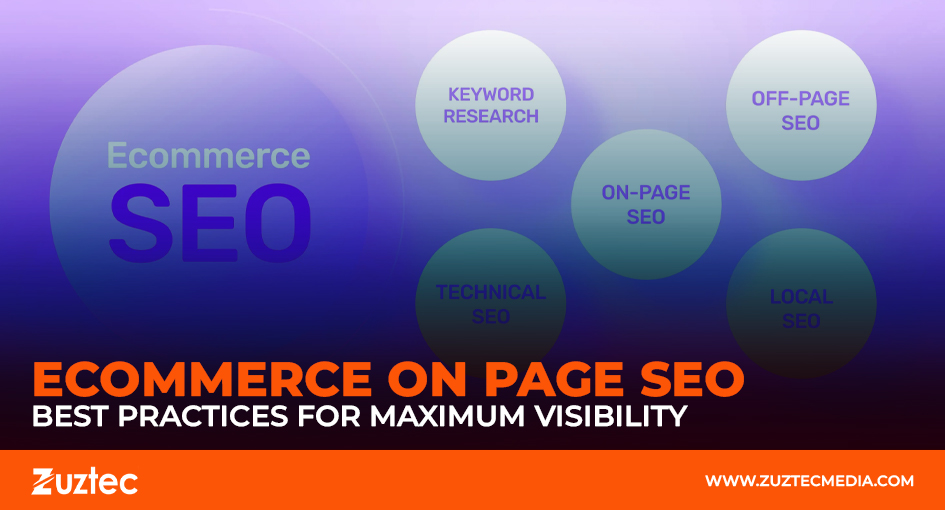
Ecommerce On Page SEO Best Practices for Maximum Visibility
In the highly competitive world of ecommerce, standing out in search engine results is more important than ever for attracting potential customers and boosting sales. With countless online stores vying for attention, having a visually appealing site is no longer enough. To truly succeed in the digital marketplace, your ecommerce store needs to rank high on search engine results pages (SERPs), where users are more likely to click and engage with your content. One of the most effective ways to improve your store’s visibility is through ecommerce on page SEO.
Ecommerce on-page SEO is the process of optimizing various elements within your website to improve its ranking on search engines, ensuring your store appears in front of potential customers when they search for products or services you offer. This optimization process includes improving key aspects such as product pages, meta descriptions, image alt text, URL structure, and site speed. Even small changes in these areas can lead to significant improvements in your search engine rankings, organic traffic, and conversion rates.
This article will explore the best practices for ecommerce on page SEO that can help you achieve maximum visibility in a crowded market. By following these strategies, you can not only improve your site’s SEO performance but also enhance the overall user experience, ultimately driving more organic traffic to your store and increasing sales and customer retention.
What is Ecommerce On Page SEO?
Ecommerce on-page SEO refers to the process of optimizing elements on individual pages of your ecommerce website to improve its visibility in search engines. It includes optimizing key aspects like titles, meta descriptions, headings, product descriptions, images, and more. The goal is to make your website more appealing to both search engines and users, ensuring that it ranks well for relevant keywords and delivers a seamless experience for potential customers.
By focusing on these on-page elements, you increase your chances of ranking higher on SERPs, which leads to more organic traffic, better user engagement, and ultimately higher conversion rates.
1. Optimize Product Titles and Descriptions
The product title and description are two of the most important factors when it comes to ecommerce on page SEO. Product titles should be clear, descriptive, and include relevant keywords that potential customers might use when searching for your products. For example, instead of a generic title like “T-shirt,” use a more descriptive one like “Men’s Cotton V-Neck T-shirt – Available in Multiple Colors.”
Product descriptions should not only highlight the features and benefits of the product but also include important keywords. However, avoid keyword stuffing—ensure the content is informative, engaging, and useful for customers. A well-written product description provides valuable information and helps search engines understand the relevance of the page.
2. Focus on High-Quality Product Images
Images play a significant role in ecommerce on-page SEO because they enhance user experience and can directly impact your site’s rankings. Search engines, like Google, can index images based on their file names and alt text. Therefore, it’s essential to use descriptive filenames for your images (e.g., “red-leather-jacket.jpg”) and write detailed alt text that includes relevant keywords.
Additionally, ensure that the images are optimized for fast loading times. Slow-loading images can increase bounce rates and negatively affect your SEO rankings. Tools like image compressors can help reduce file sizes without sacrificing image quality, improving both user experience and SEO performance.
3. Improve URL Structure
Having clean, SEO-friendly URLs is a fundamental aspect of ecommerce on page SEOURLs ought to be brief, informative, and contain pertinent keywords. Avoid long, confusing URLs with unnecessary parameters. A well-structured URL not only improves SEO but also makes it easier for customers to understand and share. URLs that clearly describe the product are more likely to be clicked on and remembered, contributing to better user experience and higher visibility on search engines.
4. Enhance Site Speed
Page load speed is a critical ranking factor for both user experience and SEO. A slow-loading ecommerce site can cause visitors to abandon your store before making a purchase, which can negatively impact your SEO rankings. ecommerce on page SEO best practices include optimizing your website’s speed by compressing images, using browser caching, and utilizing content delivery networks (CDNs) to serve content faster.
Google’s PageSpeed Insights is a helpful tool for measuring your site’s speed and identifying areas for improvement. Aim for a loading time of under three seconds, as this is the threshold where users tend to start abandoning pages.
5. Use Proper Header Tags (H1, H2, H3)
Properly structuring your content with header tags is essential for both readability and SEO. The H1 tag should be used for the main title of the page, usually the product name or category, and it should include your primary keyword. H2 and H3 tags are used for subheadings, which help break the content into digestible sections.
Using header tags properly allows search engines to better understand the structure and relevance of your content, improving your chances of ranking for targeted keywords. It also makes your content more user-friendly by guiding customers through the page.
In conclusion, implementing ecommerce on page SEO best practices is crucial for achieving maximum visibility in search engine results and driving more organic traffic to your online store. By optimizing your product titles, descriptions, images, URLs, and site speed, and by focusing on mobile optimization, internal linking, and user reviews, you can improve your site’s rankings and user experience. These efforts not only boost your SEO but also help convert visitors into loyal customers, ultimately increasing sales and ensuring long-term success for your ecommerce business.

